Engineering Research: Interlocking Timber Blocks and Shear Loading
VerifiedAdded on 2022/09/29
|10
|2416
|20
Report
AI Summary
This report presents a comprehensive analysis of interlocking timber blocks under shear loading, focusing on their structural behavior and performance. The research aims to evaluate the properties of these blocks when subjected to shear forces, with specific objectives including determining ideal shear test methods. The scope of the study encompasses an examination of existing literature and experimental data, including shear wall testing systems and various wall typologies such as unreinforced timber-confined walls, reinforced timber-encircled walls, and timber-surrounded walls. The literature review delves into the impact of vertical pre-pressure, the effects of reinforcing materials, and the resulting load-displacement characteristics. Key findings highlight the influence of vertical load on lateral resistance, the development of shear and flexural behavior, and the role of factors like squeezing and stiffness degradation. The report concludes by providing valuable insights into the cyclic behavior of timber-surrounded walls, contributing to the current body of knowledge on timber construction and its application in modern structural engineering.
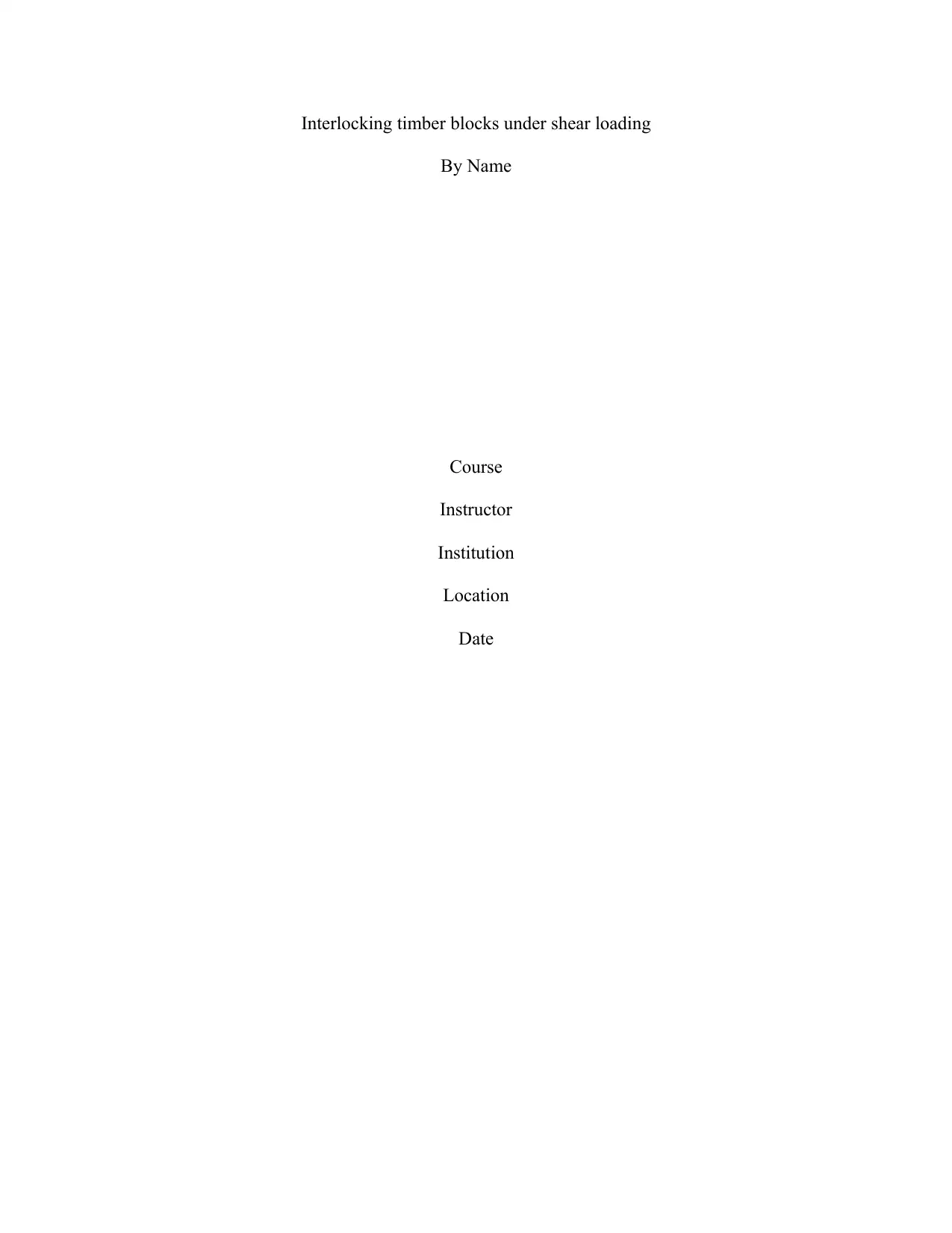
Interlocking timber blocks under shear loading
By Name
Course
Instructor
Institution
Location
Date
By Name
Course
Instructor
Institution
Location
Date
Paraphrase This Document
Need a fresh take? Get an instant paraphrase of this document with our AI Paraphraser
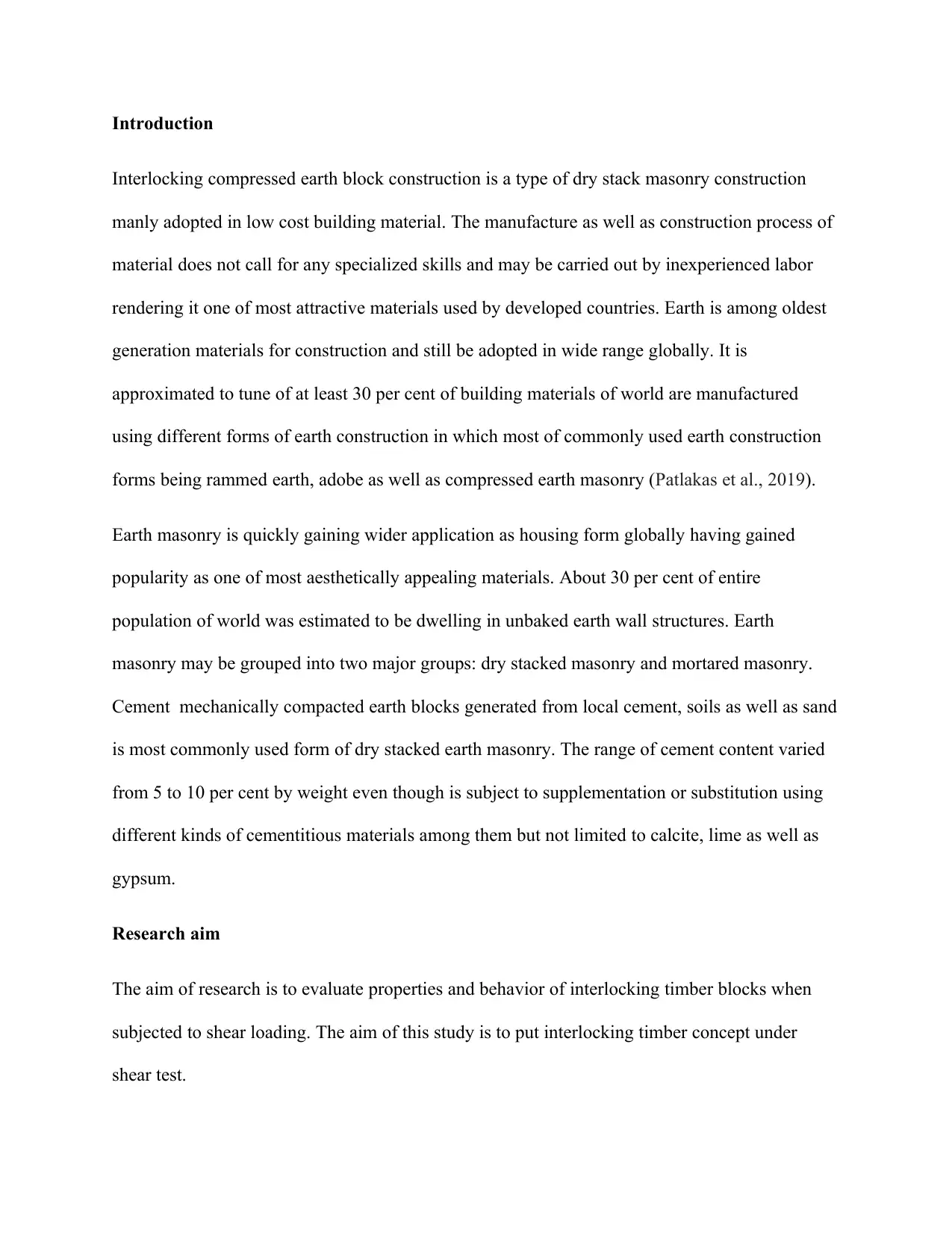
Introduction
Interlocking compressed earth block construction is a type of dry stack masonry construction
manly adopted in low cost building material. The manufacture as well as construction process of
material does not call for any specialized skills and may be carried out by inexperienced labor
rendering it one of most attractive materials used by developed countries. Earth is among oldest
generation materials for construction and still be adopted in wide range globally. It is
approximated to tune of at least 30 per cent of building materials of world are manufactured
using different forms of earth construction in which most of commonly used earth construction
forms being rammed earth, adobe as well as compressed earth masonry (Patlakas et al., 2019).
Earth masonry is quickly gaining wider application as housing form globally having gained
popularity as one of most aesthetically appealing materials. About 30 per cent of entire
population of world was estimated to be dwelling in unbaked earth wall structures. Earth
masonry may be grouped into two major groups: dry stacked masonry and mortared masonry.
Cement mechanically compacted earth blocks generated from local cement, soils as well as sand
is most commonly used form of dry stacked earth masonry. The range of cement content varied
from 5 to 10 per cent by weight even though is subject to supplementation or substitution using
different kinds of cementitious materials among them but not limited to calcite, lime as well as
gypsum.
Research aim
The aim of research is to evaluate properties and behavior of interlocking timber blocks when
subjected to shear loading. The aim of this study is to put interlocking timber concept under
shear test.
Interlocking compressed earth block construction is a type of dry stack masonry construction
manly adopted in low cost building material. The manufacture as well as construction process of
material does not call for any specialized skills and may be carried out by inexperienced labor
rendering it one of most attractive materials used by developed countries. Earth is among oldest
generation materials for construction and still be adopted in wide range globally. It is
approximated to tune of at least 30 per cent of building materials of world are manufactured
using different forms of earth construction in which most of commonly used earth construction
forms being rammed earth, adobe as well as compressed earth masonry (Patlakas et al., 2019).
Earth masonry is quickly gaining wider application as housing form globally having gained
popularity as one of most aesthetically appealing materials. About 30 per cent of entire
population of world was estimated to be dwelling in unbaked earth wall structures. Earth
masonry may be grouped into two major groups: dry stacked masonry and mortared masonry.
Cement mechanically compacted earth blocks generated from local cement, soils as well as sand
is most commonly used form of dry stacked earth masonry. The range of cement content varied
from 5 to 10 per cent by weight even though is subject to supplementation or substitution using
different kinds of cementitious materials among them but not limited to calcite, lime as well as
gypsum.
Research aim
The aim of research is to evaluate properties and behavior of interlocking timber blocks when
subjected to shear loading. The aim of this study is to put interlocking timber concept under
shear test.
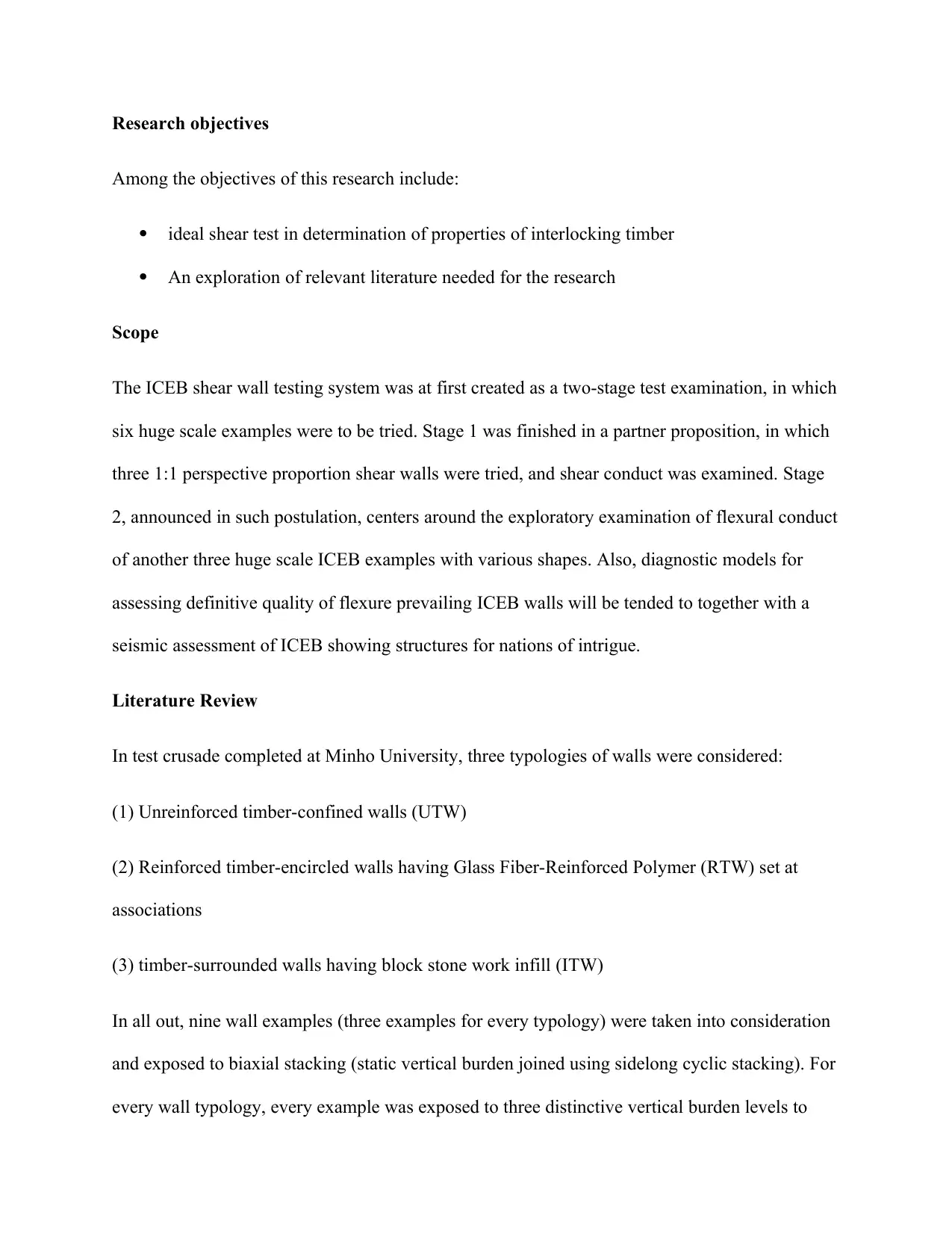
Research objectives
Among the objectives of this research include:
ideal shear test in determination of properties of interlocking timber
An exploration of relevant literature needed for the research
Scope
The ICEB shear wall testing system was at first created as a two-stage test examination, in which
six huge scale examples were to be tried. Stage 1 was finished in a partner proposition, in which
three 1:1 perspective proportion shear walls were tried, and shear conduct was examined. Stage
2, announced in such postulation, centers around the exploratory examination of flexural conduct
of another three huge scale ICEB examples with various shapes. Also, diagnostic models for
assessing definitive quality of flexure prevailing ICEB walls will be tended to together with a
seismic assessment of ICEB showing structures for nations of intrigue.
Literature Review
In test crusade completed at Minho University, three typologies of walls were considered:
(1) Unreinforced timber-confined walls (UTW)
(2) Reinforced timber-encircled walls having Glass Fiber-Reinforced Polymer (RTW) set at
associations
(3) timber-surrounded walls having block stone work infill (ITW)
In all out, nine wall examples (three examples for every typology) were taken into consideration
and exposed to biaxial stacking (static vertical burden joined using sidelong cyclic stacking). For
every wall typology, every example was exposed to three distinctive vertical burden levels to
Among the objectives of this research include:
ideal shear test in determination of properties of interlocking timber
An exploration of relevant literature needed for the research
Scope
The ICEB shear wall testing system was at first created as a two-stage test examination, in which
six huge scale examples were to be tried. Stage 1 was finished in a partner proposition, in which
three 1:1 perspective proportion shear walls were tried, and shear conduct was examined. Stage
2, announced in such postulation, centers around the exploratory examination of flexural conduct
of another three huge scale ICEB examples with various shapes. Also, diagnostic models for
assessing definitive quality of flexure prevailing ICEB walls will be tended to together with a
seismic assessment of ICEB showing structures for nations of intrigue.
Literature Review
In test crusade completed at Minho University, three typologies of walls were considered:
(1) Unreinforced timber-confined walls (UTW)
(2) Reinforced timber-encircled walls having Glass Fiber-Reinforced Polymer (RTW) set at
associations
(3) timber-surrounded walls having block stone work infill (ITW)
In all out, nine wall examples (three examples for every typology) were taken into consideration
and exposed to biaxial stacking (static vertical burden joined using sidelong cyclic stacking). For
every wall typology, every example was exposed to three distinctive vertical burden levels to
⊘ This is a preview!⊘
Do you want full access?
Subscribe today to unlock all pages.

Trusted by 1+ million students worldwide
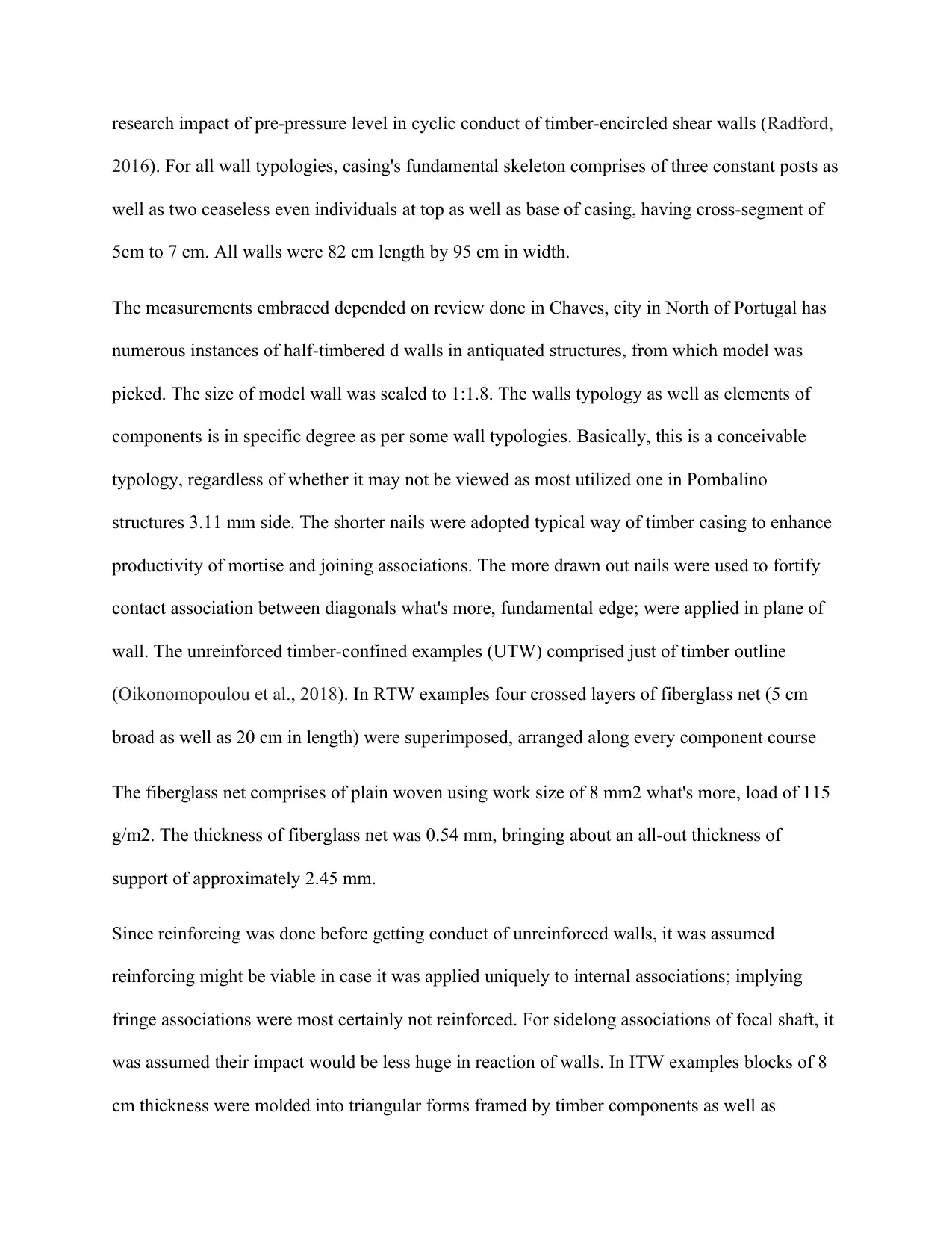
research impact of pre-pressure level in cyclic conduct of timber-encircled shear walls (Radford,
2016). For all wall typologies, casing's fundamental skeleton comprises of three constant posts as
well as two ceaseless even individuals at top as well as base of casing, having cross-segment of
5cm to 7 cm. All walls were 82 cm length by 95 cm in width.
The measurements embraced depended on review done in Chaves, city in North of Portugal has
numerous instances of half-timbered d walls in antiquated structures, from which model was
picked. The size of model wall was scaled to 1:1.8. The walls typology as well as elements of
components is in specific degree as per some wall typologies. Basically, this is a conceivable
typology, regardless of whether it may not be viewed as most utilized one in Pombalino
structures 3.11 mm side. The shorter nails were adopted typical way of timber casing to enhance
productivity of mortise and joining associations. The more drawn out nails were used to fortify
contact association between diagonals what's more, fundamental edge; were applied in plane of
wall. The unreinforced timber-confined examples (UTW) comprised just of timber outline
(Oikonomopoulou et al., 2018). In RTW examples four crossed layers of fiberglass net (5 cm
broad as well as 20 cm in length) were superimposed, arranged along every component course
The fiberglass net comprises of plain woven using work size of 8 mm2 what's more, load of 115
g/m2. The thickness of fiberglass net was 0.54 mm, bringing about an all-out thickness of
support of approximately 2.45 mm.
Since reinforcing was done before getting conduct of unreinforced walls, it was assumed
reinforcing might be viable in case it was applied uniquely to internal associations; implying
fringe associations were most certainly not reinforced. For sidelong associations of focal shaft, it
was assumed their impact would be less huge in reaction of walls. In ITW examples blocks of 8
cm thickness were molded into triangular forms framed by timber components as well as
2016). For all wall typologies, casing's fundamental skeleton comprises of three constant posts as
well as two ceaseless even individuals at top as well as base of casing, having cross-segment of
5cm to 7 cm. All walls were 82 cm length by 95 cm in width.
The measurements embraced depended on review done in Chaves, city in North of Portugal has
numerous instances of half-timbered d walls in antiquated structures, from which model was
picked. The size of model wall was scaled to 1:1.8. The walls typology as well as elements of
components is in specific degree as per some wall typologies. Basically, this is a conceivable
typology, regardless of whether it may not be viewed as most utilized one in Pombalino
structures 3.11 mm side. The shorter nails were adopted typical way of timber casing to enhance
productivity of mortise and joining associations. The more drawn out nails were used to fortify
contact association between diagonals what's more, fundamental edge; were applied in plane of
wall. The unreinforced timber-confined examples (UTW) comprised just of timber outline
(Oikonomopoulou et al., 2018). In RTW examples four crossed layers of fiberglass net (5 cm
broad as well as 20 cm in length) were superimposed, arranged along every component course
The fiberglass net comprises of plain woven using work size of 8 mm2 what's more, load of 115
g/m2. The thickness of fiberglass net was 0.54 mm, bringing about an all-out thickness of
support of approximately 2.45 mm.
Since reinforcing was done before getting conduct of unreinforced walls, it was assumed
reinforcing might be viable in case it was applied uniquely to internal associations; implying
fringe associations were most certainly not reinforced. For sidelong associations of focal shaft, it
was assumed their impact would be less huge in reaction of walls. In ITW examples blocks of 8
cm thickness were molded into triangular forms framed by timber components as well as
Paraphrase This Document
Need a fresh take? Get an instant paraphrase of this document with our AI Paraphraser
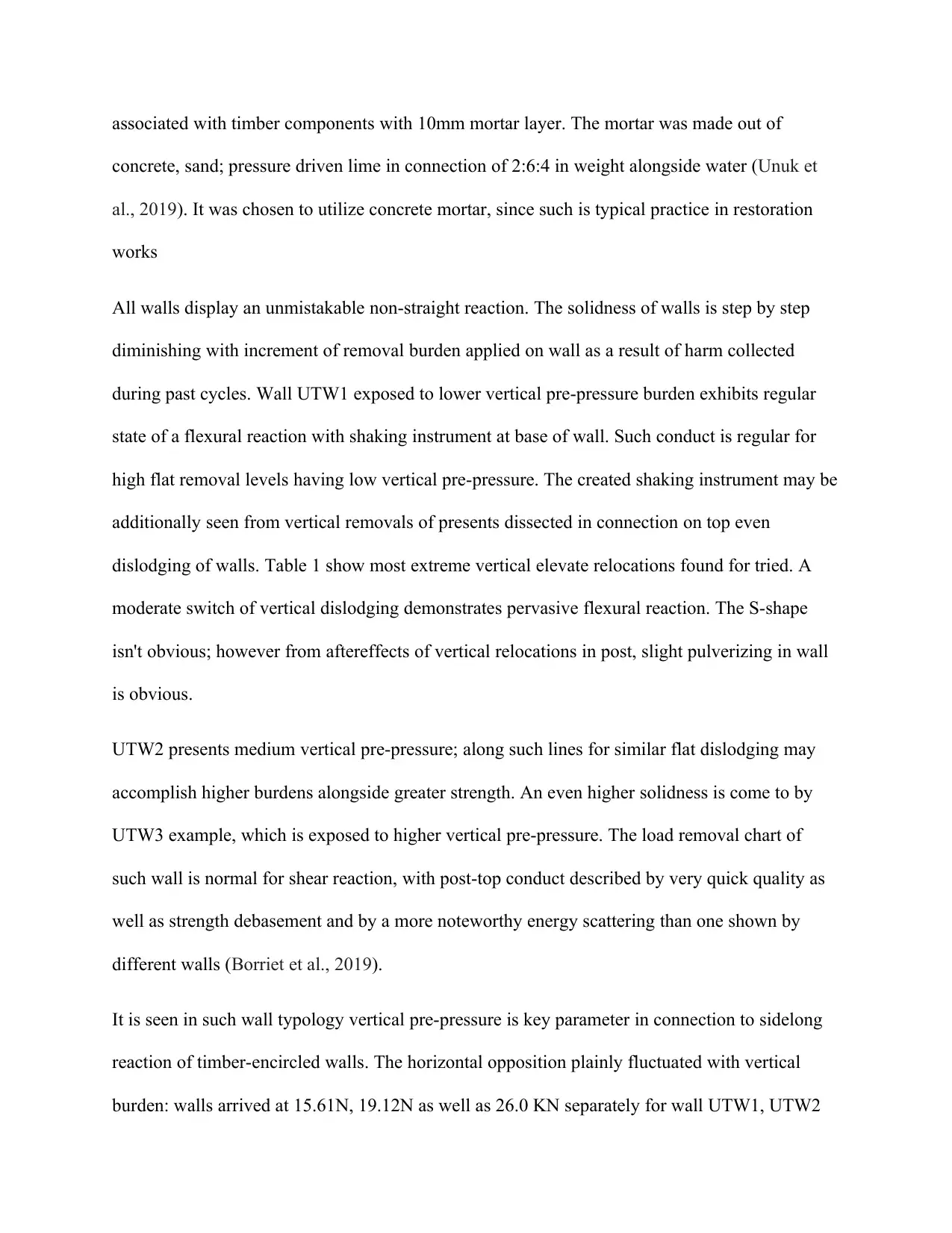
associated with timber components with 10mm mortar layer. The mortar was made out of
concrete, sand; pressure driven lime in connection of 2:6:4 in weight alongside water (Unuk et
al., 2019). It was chosen to utilize concrete mortar, since such is typical practice in restoration
works
All walls display an unmistakable non-straight reaction. The solidness of walls is step by step
diminishing with increment of removal burden applied on wall as a result of harm collected
during past cycles. Wall UTW1 exposed to lower vertical pre-pressure burden exhibits regular
state of a flexural reaction with shaking instrument at base of wall. Such conduct is regular for
high flat removal levels having low vertical pre-pressure. The created shaking instrument may be
additionally seen from vertical removals of presents dissected in connection on top even
dislodging of walls. Table 1 show most extreme vertical elevate relocations found for tried. A
moderate switch of vertical dislodging demonstrates pervasive flexural reaction. The S-shape
isn't obvious; however from aftereffects of vertical relocations in post, slight pulverizing in wall
is obvious.
UTW2 presents medium vertical pre-pressure; along such lines for similar flat dislodging may
accomplish higher burdens alongside greater strength. An even higher solidness is come to by
UTW3 example, which is exposed to higher vertical pre-pressure. The load removal chart of
such wall is normal for shear reaction, with post-top conduct described by very quick quality as
well as strength debasement and by a more noteworthy energy scattering than one shown by
different walls (Borriet et al., 2019).
It is seen in such wall typology vertical pre-pressure is key parameter in connection to sidelong
reaction of timber-encircled walls. The horizontal opposition plainly fluctuated with vertical
burden: walls arrived at 15.61N, 19.12N as well as 26.0 KN separately for wall UTW1, UTW2
concrete, sand; pressure driven lime in connection of 2:6:4 in weight alongside water (Unuk et
al., 2019). It was chosen to utilize concrete mortar, since such is typical practice in restoration
works
All walls display an unmistakable non-straight reaction. The solidness of walls is step by step
diminishing with increment of removal burden applied on wall as a result of harm collected
during past cycles. Wall UTW1 exposed to lower vertical pre-pressure burden exhibits regular
state of a flexural reaction with shaking instrument at base of wall. Such conduct is regular for
high flat removal levels having low vertical pre-pressure. The created shaking instrument may be
additionally seen from vertical removals of presents dissected in connection on top even
dislodging of walls. Table 1 show most extreme vertical elevate relocations found for tried. A
moderate switch of vertical dislodging demonstrates pervasive flexural reaction. The S-shape
isn't obvious; however from aftereffects of vertical relocations in post, slight pulverizing in wall
is obvious.
UTW2 presents medium vertical pre-pressure; along such lines for similar flat dislodging may
accomplish higher burdens alongside greater strength. An even higher solidness is come to by
UTW3 example, which is exposed to higher vertical pre-pressure. The load removal chart of
such wall is normal for shear reaction, with post-top conduct described by very quick quality as
well as strength debasement and by a more noteworthy energy scattering than one shown by
different walls (Borriet et al., 2019).
It is seen in such wall typology vertical pre-pressure is key parameter in connection to sidelong
reaction of timber-encircled walls. The horizontal opposition plainly fluctuated with vertical
burden: walls arrived at 15.61N, 19.12N as well as 26.0 KN separately for wall UTW1, UTW2
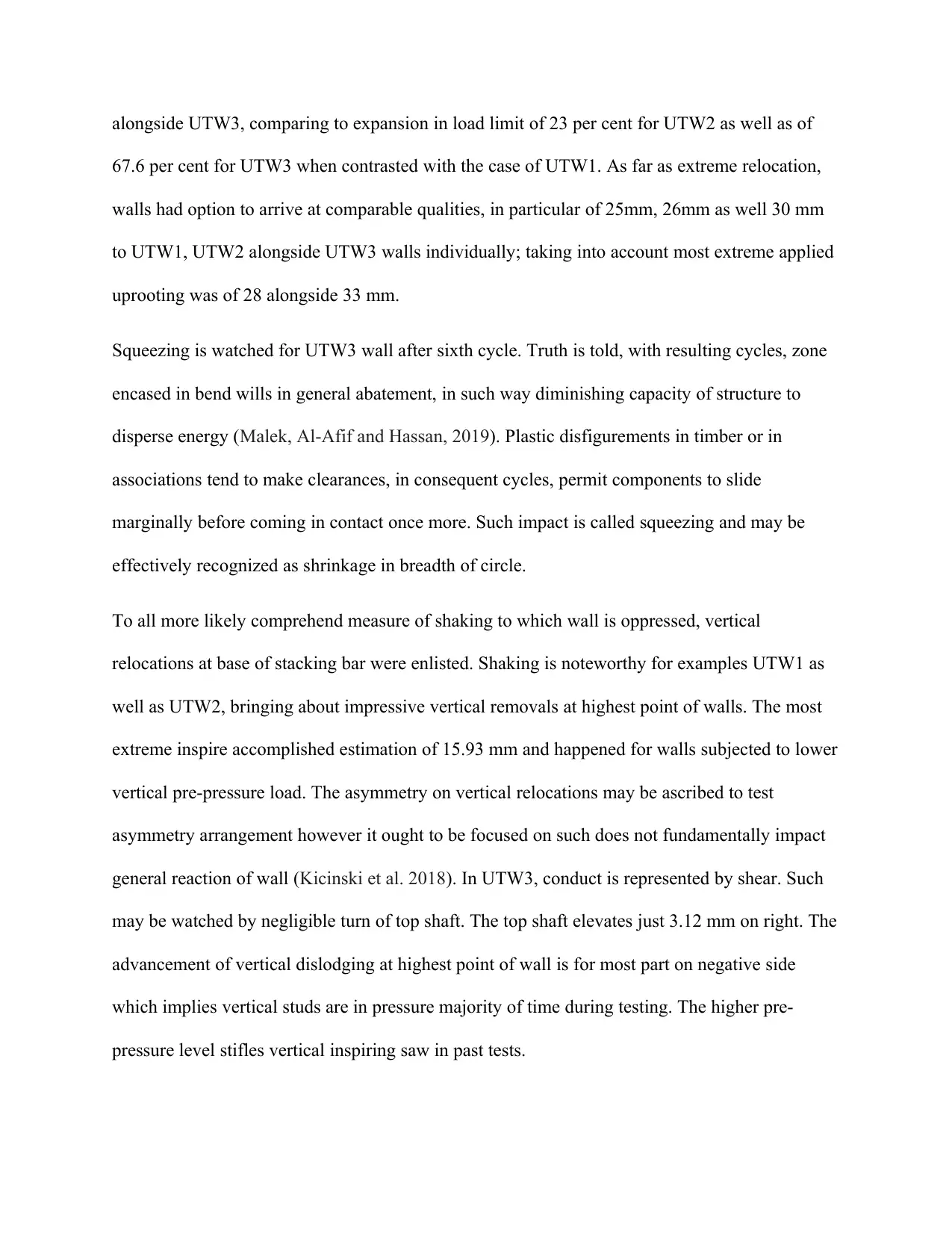
alongside UTW3, comparing to expansion in load limit of 23 per cent for UTW2 as well as of
67.6 per cent for UTW3 when contrasted with the case of UTW1. As far as extreme relocation,
walls had option to arrive at comparable qualities, in particular of 25mm, 26mm as well 30 mm
to UTW1, UTW2 alongside UTW3 walls individually; taking into account most extreme applied
uprooting was of 28 alongside 33 mm.
Squeezing is watched for UTW3 wall after sixth cycle. Truth is told, with resulting cycles, zone
encased in bend wills in general abatement, in such way diminishing capacity of structure to
disperse energy (Malek, Al-Afif and Hassan, 2019). Plastic disfigurements in timber or in
associations tend to make clearances, in consequent cycles, permit components to slide
marginally before coming in contact once more. Such impact is called squeezing and may be
effectively recognized as shrinkage in breadth of circle.
To all more likely comprehend measure of shaking to which wall is oppressed, vertical
relocations at base of stacking bar were enlisted. Shaking is noteworthy for examples UTW1 as
well as UTW2, bringing about impressive vertical removals at highest point of walls. The most
extreme inspire accomplished estimation of 15.93 mm and happened for walls subjected to lower
vertical pre-pressure load. The asymmetry on vertical relocations may be ascribed to test
asymmetry arrangement however it ought to be focused on such does not fundamentally impact
general reaction of wall (Kicinski et al. 2018). In UTW3, conduct is represented by shear. Such
may be watched by negligible turn of top shaft. The top shaft elevates just 3.12 mm on right. The
advancement of vertical dislodging at highest point of wall is for most part on negative side
which implies vertical studs are in pressure majority of time during testing. The higher pre-
pressure level stifles vertical inspiring saw in past tests.
67.6 per cent for UTW3 when contrasted with the case of UTW1. As far as extreme relocation,
walls had option to arrive at comparable qualities, in particular of 25mm, 26mm as well 30 mm
to UTW1, UTW2 alongside UTW3 walls individually; taking into account most extreme applied
uprooting was of 28 alongside 33 mm.
Squeezing is watched for UTW3 wall after sixth cycle. Truth is told, with resulting cycles, zone
encased in bend wills in general abatement, in such way diminishing capacity of structure to
disperse energy (Malek, Al-Afif and Hassan, 2019). Plastic disfigurements in timber or in
associations tend to make clearances, in consequent cycles, permit components to slide
marginally before coming in contact once more. Such impact is called squeezing and may be
effectively recognized as shrinkage in breadth of circle.
To all more likely comprehend measure of shaking to which wall is oppressed, vertical
relocations at base of stacking bar were enlisted. Shaking is noteworthy for examples UTW1 as
well as UTW2, bringing about impressive vertical removals at highest point of walls. The most
extreme inspire accomplished estimation of 15.93 mm and happened for walls subjected to lower
vertical pre-pressure load. The asymmetry on vertical relocations may be ascribed to test
asymmetry arrangement however it ought to be focused on such does not fundamentally impact
general reaction of wall (Kicinski et al. 2018). In UTW3, conduct is represented by shear. Such
may be watched by negligible turn of top shaft. The top shaft elevates just 3.12 mm on right. The
advancement of vertical dislodging at highest point of wall is for most part on negative side
which implies vertical studs are in pressure majority of time during testing. The higher pre-
pressure level stifles vertical inspiring saw in past tests.
⊘ This is a preview!⊘
Do you want full access?
Subscribe today to unlock all pages.

Trusted by 1+ million students worldwide
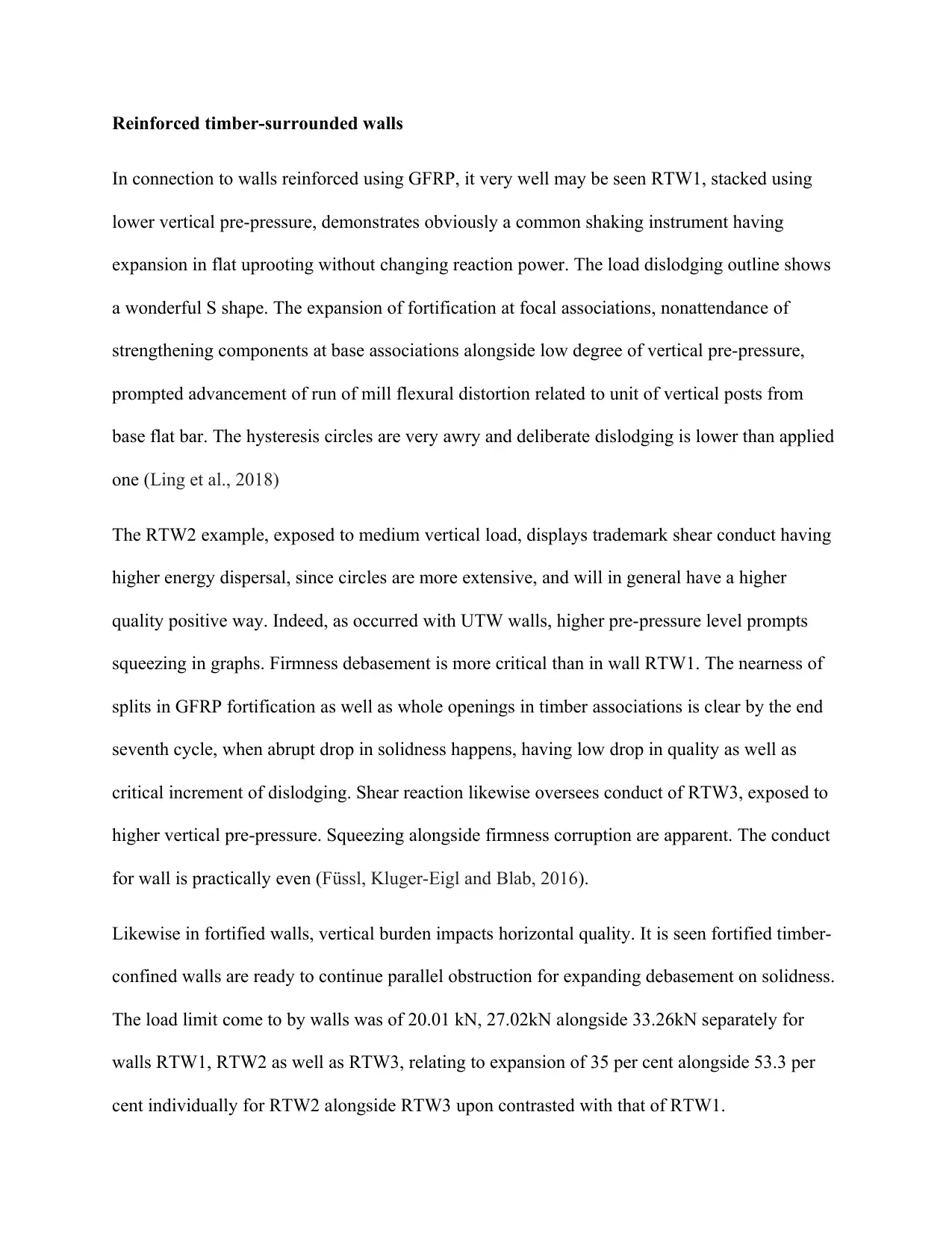
Reinforced timber-surrounded walls
In connection to walls reinforced using GFRP, it very well may be seen RTW1, stacked using
lower vertical pre-pressure, demonstrates obviously a common shaking instrument having
expansion in flat uprooting without changing reaction power. The load dislodging outline shows
a wonderful S shape. The expansion of fortification at focal associations, nonattendance of
strengthening components at base associations alongside low degree of vertical pre-pressure,
prompted advancement of run of mill flexural distortion related to unit of vertical posts from
base flat bar. The hysteresis circles are very awry and deliberate dislodging is lower than applied
one (Ling et al., 2018)
The RTW2 example, exposed to medium vertical load, displays trademark shear conduct having
higher energy dispersal, since circles are more extensive, and will in general have a higher
quality positive way. Indeed, as occurred with UTW walls, higher pre-pressure level prompts
squeezing in graphs. Firmness debasement is more critical than in wall RTW1. The nearness of
splits in GFRP fortification as well as whole openings in timber associations is clear by the end
seventh cycle, when abrupt drop in solidness happens, having low drop in quality as well as
critical increment of dislodging. Shear reaction likewise oversees conduct of RTW3, exposed to
higher vertical pre-pressure. Squeezing alongside firmness corruption are apparent. The conduct
for wall is practically even (Füssl, Kluger-Eigl and Blab, 2016).
Likewise in fortified walls, vertical burden impacts horizontal quality. It is seen fortified timber-
confined walls are ready to continue parallel obstruction for expanding debasement on solidness.
The load limit come to by walls was of 20.01 kN, 27.02kN alongside 33.26kN separately for
walls RTW1, RTW2 as well as RTW3, relating to expansion of 35 per cent alongside 53.3 per
cent individually for RTW2 alongside RTW3 upon contrasted with that of RTW1.
In connection to walls reinforced using GFRP, it very well may be seen RTW1, stacked using
lower vertical pre-pressure, demonstrates obviously a common shaking instrument having
expansion in flat uprooting without changing reaction power. The load dislodging outline shows
a wonderful S shape. The expansion of fortification at focal associations, nonattendance of
strengthening components at base associations alongside low degree of vertical pre-pressure,
prompted advancement of run of mill flexural distortion related to unit of vertical posts from
base flat bar. The hysteresis circles are very awry and deliberate dislodging is lower than applied
one (Ling et al., 2018)
The RTW2 example, exposed to medium vertical load, displays trademark shear conduct having
higher energy dispersal, since circles are more extensive, and will in general have a higher
quality positive way. Indeed, as occurred with UTW walls, higher pre-pressure level prompts
squeezing in graphs. Firmness debasement is more critical than in wall RTW1. The nearness of
splits in GFRP fortification as well as whole openings in timber associations is clear by the end
seventh cycle, when abrupt drop in solidness happens, having low drop in quality as well as
critical increment of dislodging. Shear reaction likewise oversees conduct of RTW3, exposed to
higher vertical pre-pressure. Squeezing alongside firmness corruption are apparent. The conduct
for wall is practically even (Füssl, Kluger-Eigl and Blab, 2016).
Likewise in fortified walls, vertical burden impacts horizontal quality. It is seen fortified timber-
confined walls are ready to continue parallel obstruction for expanding debasement on solidness.
The load limit come to by walls was of 20.01 kN, 27.02kN alongside 33.26kN separately for
walls RTW1, RTW2 as well as RTW3, relating to expansion of 35 per cent alongside 53.3 per
cent individually for RTW2 alongside RTW3 upon contrasted with that of RTW1.
Paraphrase This Document
Need a fresh take? Get an instant paraphrase of this document with our AI Paraphraser
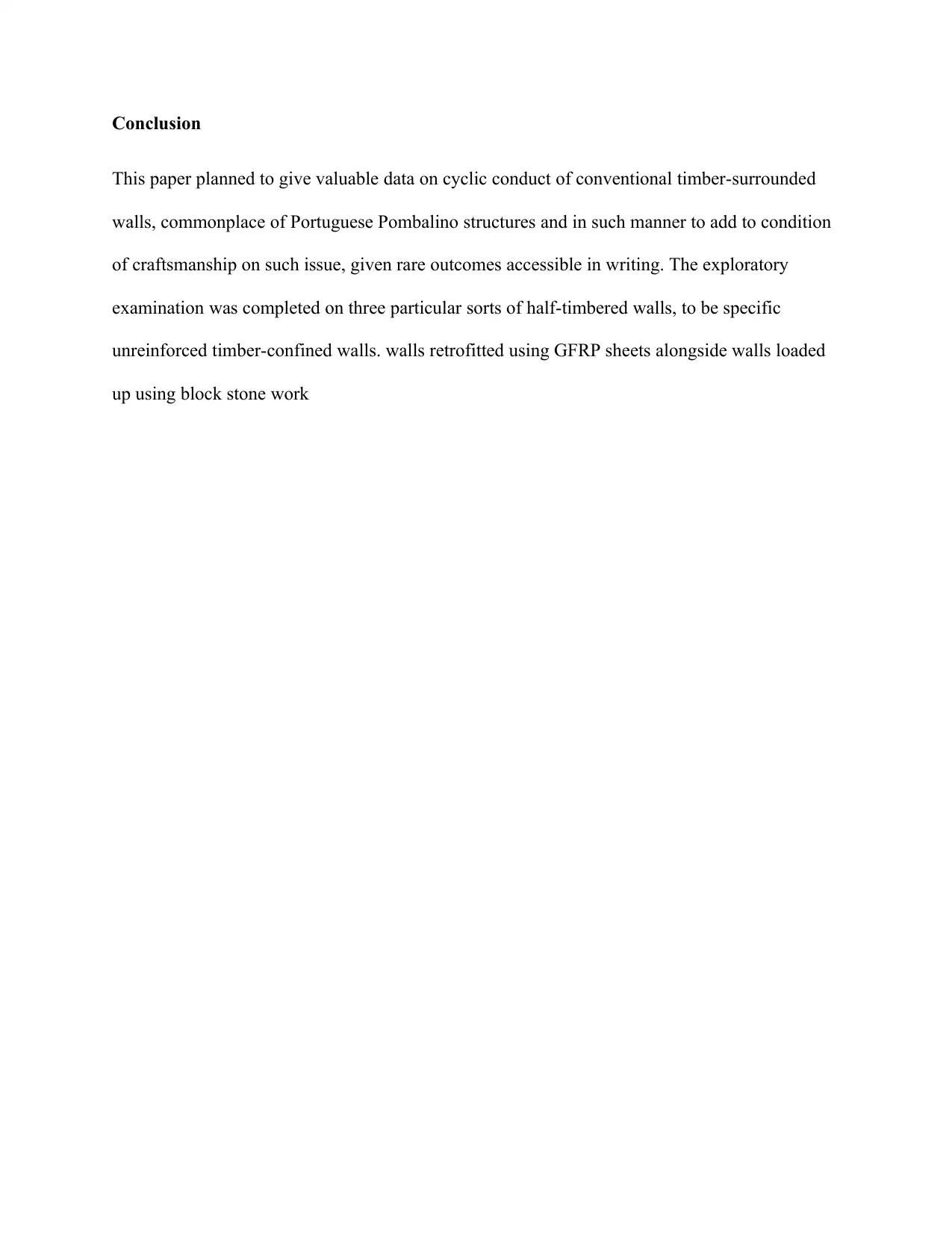
Conclusion
This paper planned to give valuable data on cyclic conduct of conventional timber-surrounded
walls, commonplace of Portuguese Pombalino structures and in such manner to add to condition
of craftsmanship on such issue, given rare outcomes accessible in writing. The exploratory
examination was completed on three particular sorts of half-timbered walls, to be specific
unreinforced timber-confined walls. walls retrofitted using GFRP sheets alongside walls loaded
up using block stone work
This paper planned to give valuable data on cyclic conduct of conventional timber-surrounded
walls, commonplace of Portuguese Pombalino structures and in such manner to add to condition
of craftsmanship on such issue, given rare outcomes accessible in writing. The exploratory
examination was completed on three particular sorts of half-timbered walls, to be specific
unreinforced timber-confined walls. walls retrofitted using GFRP sheets alongside walls loaded
up using block stone work
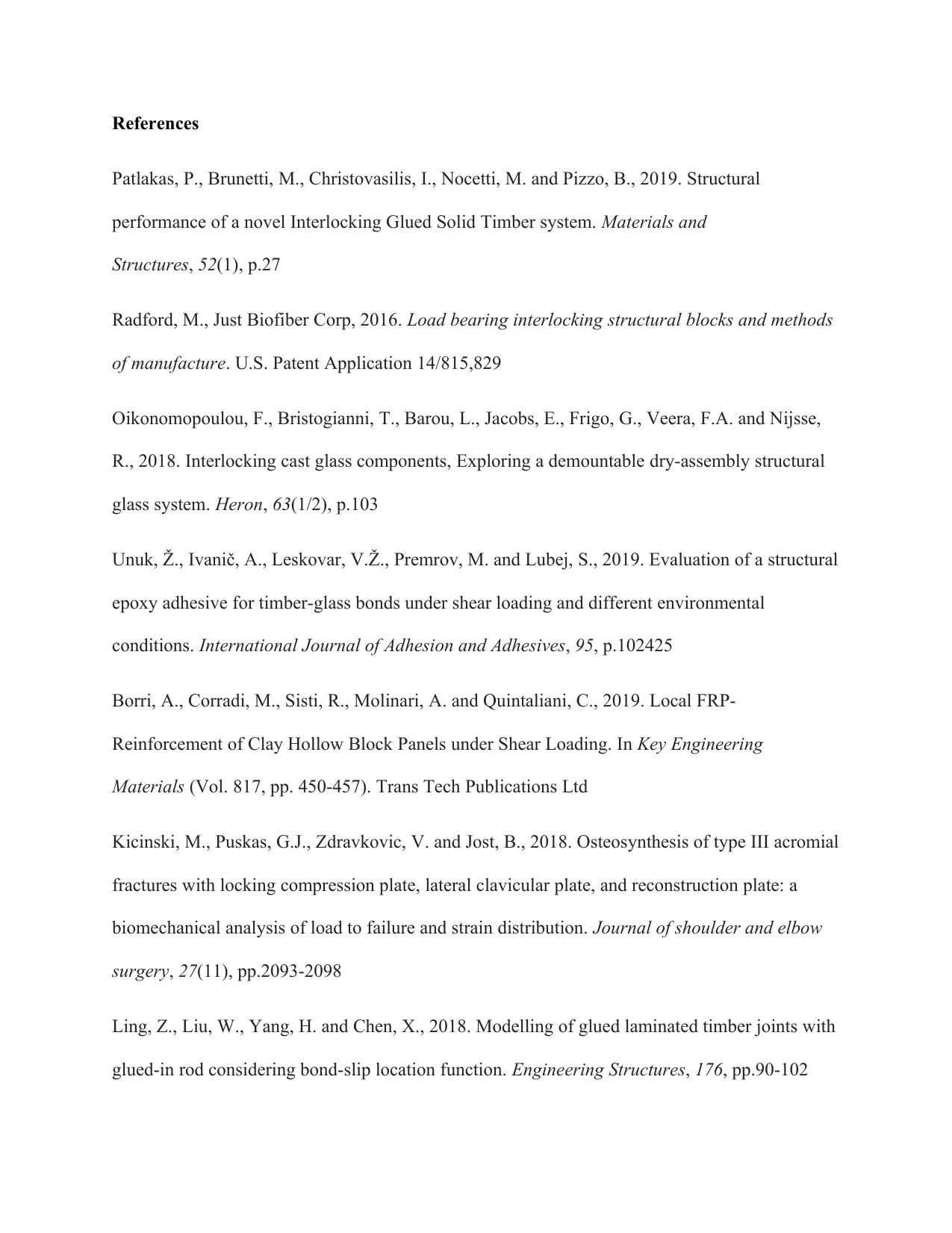
References
Patlakas, P., Brunetti, M., Christovasilis, I., Nocetti, M. and Pizzo, B., 2019. Structural
performance of a novel Interlocking Glued Solid Timber system. Materials and
Structures, 52(1), p.27
Radford, M., Just Biofiber Corp, 2016. Load bearing interlocking structural blocks and methods
of manufacture. U.S. Patent Application 14/815,829
Oikonomopoulou, F., Bristogianni, T., Barou, L., Jacobs, E., Frigo, G., Veera, F.A. and Nijsse,
R., 2018. Interlocking cast glass components, Exploring a demountable dry-assembly structural
glass system. Heron, 63(1/2), p.103
Unuk, Ž., Ivanič, A., Leskovar, V.Ž., Premrov, M. and Lubej, S., 2019. Evaluation of a structural
epoxy adhesive for timber-glass bonds under shear loading and different environmental
conditions. International Journal of Adhesion and Adhesives, 95, p.102425
Borri, A., Corradi, M., Sisti, R., Molinari, A. and Quintaliani, C., 2019. Local FRP-
Reinforcement of Clay Hollow Block Panels under Shear Loading. In Key Engineering
Materials (Vol. 817, pp. 450-457). Trans Tech Publications Ltd
Kicinski, M., Puskas, G.J., Zdravkovic, V. and Jost, B., 2018. Osteosynthesis of type III acromial
fractures with locking compression plate, lateral clavicular plate, and reconstruction plate: a
biomechanical analysis of load to failure and strain distribution. Journal of shoulder and elbow
surgery, 27(11), pp.2093-2098
Ling, Z., Liu, W., Yang, H. and Chen, X., 2018. Modelling of glued laminated timber joints with
glued-in rod considering bond-slip location function. Engineering Structures, 176, pp.90-102
Patlakas, P., Brunetti, M., Christovasilis, I., Nocetti, M. and Pizzo, B., 2019. Structural
performance of a novel Interlocking Glued Solid Timber system. Materials and
Structures, 52(1), p.27
Radford, M., Just Biofiber Corp, 2016. Load bearing interlocking structural blocks and methods
of manufacture. U.S. Patent Application 14/815,829
Oikonomopoulou, F., Bristogianni, T., Barou, L., Jacobs, E., Frigo, G., Veera, F.A. and Nijsse,
R., 2018. Interlocking cast glass components, Exploring a demountable dry-assembly structural
glass system. Heron, 63(1/2), p.103
Unuk, Ž., Ivanič, A., Leskovar, V.Ž., Premrov, M. and Lubej, S., 2019. Evaluation of a structural
epoxy adhesive for timber-glass bonds under shear loading and different environmental
conditions. International Journal of Adhesion and Adhesives, 95, p.102425
Borri, A., Corradi, M., Sisti, R., Molinari, A. and Quintaliani, C., 2019. Local FRP-
Reinforcement of Clay Hollow Block Panels under Shear Loading. In Key Engineering
Materials (Vol. 817, pp. 450-457). Trans Tech Publications Ltd
Kicinski, M., Puskas, G.J., Zdravkovic, V. and Jost, B., 2018. Osteosynthesis of type III acromial
fractures with locking compression plate, lateral clavicular plate, and reconstruction plate: a
biomechanical analysis of load to failure and strain distribution. Journal of shoulder and elbow
surgery, 27(11), pp.2093-2098
Ling, Z., Liu, W., Yang, H. and Chen, X., 2018. Modelling of glued laminated timber joints with
glued-in rod considering bond-slip location function. Engineering Structures, 176, pp.90-102
⊘ This is a preview!⊘
Do you want full access?
Subscribe today to unlock all pages.

Trusted by 1+ million students worldwide
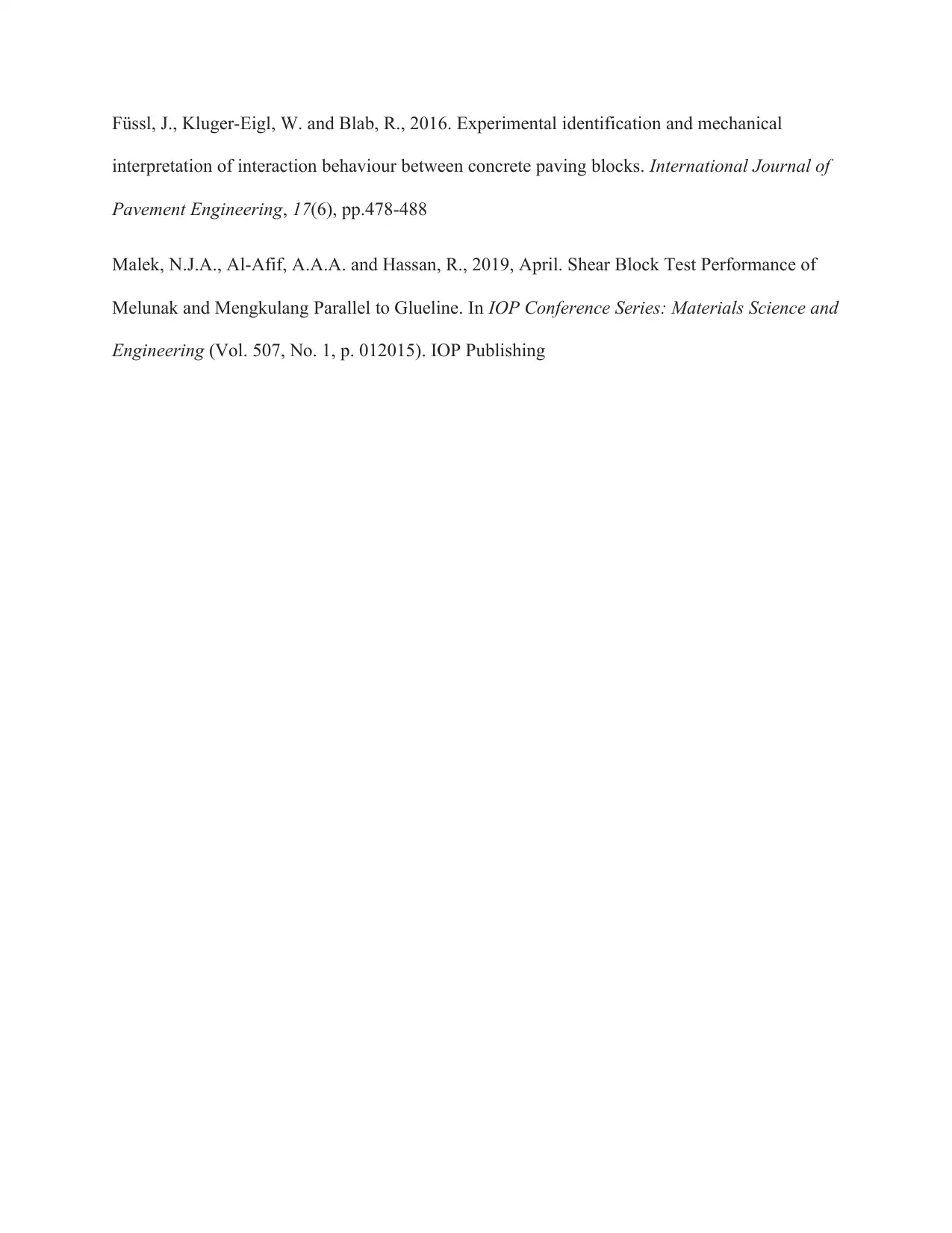
Füssl, J., Kluger-Eigl, W. and Blab, R., 2016. Experimental identification and mechanical
interpretation of interaction behaviour between concrete paving blocks. International Journal of
Pavement Engineering, 17(6), pp.478-488
Malek, N.J.A., Al-Afif, A.A.A. and Hassan, R., 2019, April. Shear Block Test Performance of
Melunak and Mengkulang Parallel to Glueline. In IOP Conference Series: Materials Science and
Engineering (Vol. 507, No. 1, p. 012015). IOP Publishing
interpretation of interaction behaviour between concrete paving blocks. International Journal of
Pavement Engineering, 17(6), pp.478-488
Malek, N.J.A., Al-Afif, A.A.A. and Hassan, R., 2019, April. Shear Block Test Performance of
Melunak and Mengkulang Parallel to Glueline. In IOP Conference Series: Materials Science and
Engineering (Vol. 507, No. 1, p. 012015). IOP Publishing
1 out of 10
Your All-in-One AI-Powered Toolkit for Academic Success.
+13062052269
info@desklib.com
Available 24*7 on WhatsApp / Email
![[object Object]](/_next/static/media/star-bottom.7253800d.svg)
Unlock your academic potential
Copyright © 2020–2025 A2Z Services. All Rights Reserved. Developed and managed by ZUCOL.
